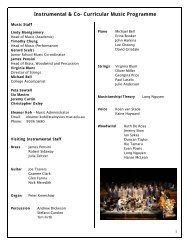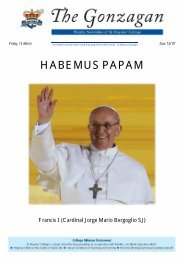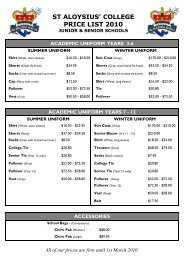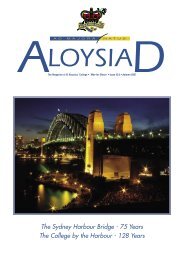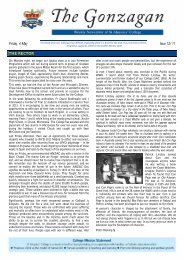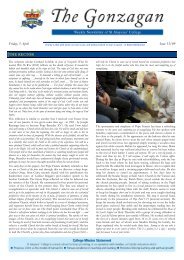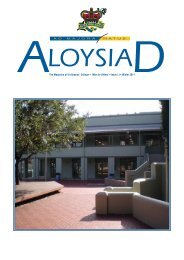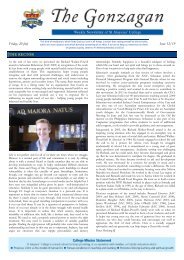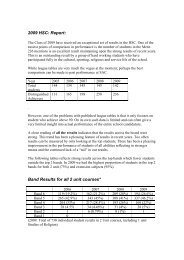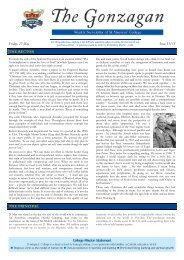The Magazine of St Aloysius' College ⢠'Men for Others' ⢠Issue XLVII ...
The Magazine of St Aloysius' College ⢠'Men for Others' ⢠Issue XLVII ...
The Magazine of St Aloysius' College ⢠'Men for Others' ⢠Issue XLVII ...
You also want an ePaper? Increase the reach of your titles
YUMPU automatically turns print PDFs into web optimized ePapers that Google loves.
from the deputy principal<br />
Dipping back, as I <strong>of</strong>ten<br />
do, into the life <strong>of</strong> <strong>St</strong><br />
Thomas Aquinas, I found<br />
again some interesting parallels<br />
with Ignatian pedagogy. Both<br />
stress the importance <strong>of</strong> the role<br />
<strong>of</strong> the teacher, what teaching is<br />
and the challenges it provides.<br />
Josef Peiper’s Guide to Thomas<br />
Aquinas reveals what brought<br />
Thomas into the Order <strong>of</strong><br />
Preachers was his passion <strong>for</strong><br />
teaching. Teaching does not<br />
consist in making public talks on the results <strong>of</strong> meditations<br />
he said, even if it is done so ex cathedra, be<strong>for</strong>e a large<br />
audience. Teaching in the real sense takes place only<br />
when the hearer is reached – not by dint <strong>of</strong> some personal<br />
magnetism or verbal magic, but rather, when the truth <strong>of</strong><br />
what is said reaches the hearer as truth.<br />
Real teaching he said, takes place only when its<br />
ultimate result - which must be intended from the start - is<br />
achieved; that is, when the hearer is “taught”. Being taught<br />
is something else again from being carried away, and<br />
something else again from being dominated by another’s<br />
intellect. Being taught, to Thomas, meant to perceive that<br />
what the teacher has said is true and valid, and to perceive<br />
why this is so. Teaching, there<strong>for</strong>e, presupposes that the<br />
hearer is sought out where he or she is to be found; bearing<br />
a striking resemblance to an age old maxim <strong>of</strong> Ignatius who<br />
pre-dated Thomas, that you meet people where they are at,<br />
not where you want them to be.<br />
That is the nature <strong>of</strong> teaching as Thomas understood it.<br />
Teaching, says Thomas, is one <strong>of</strong> the highest manifestations<br />
<strong>of</strong> the life <strong>of</strong> the mind. <strong>The</strong> teacher simultaneously looks<br />
into the faces <strong>of</strong> living human beings and undertakes the<br />
rigorously disciplined, <strong>of</strong>ten wearisome labour <strong>of</strong> clarifying,<br />
<strong>of</strong> presenting, <strong>of</strong> communicating. Where this communication<br />
does not take place, teaching does not take place.<br />
<strong>The</strong>re are interesting parallels with Ignatian pedagogy<br />
and methodology here which we explored in an introductory<br />
way with our new parents over the course <strong>of</strong> two evenings<br />
in the first part <strong>of</strong> the year, as we have done now <strong>for</strong><br />
some years. Fr Ross Jones SJ and Mr Bill Irwin joined me<br />
in presenting to our new parents the essence <strong>of</strong> Ignatian<br />
spirituality and how it has impacted on the Jesuit Order,<br />
leading to a Jesuit approach to their various ministries, such<br />
as education. <strong>The</strong> characteristics <strong>of</strong> Jesuit Education were<br />
explored and unravelled, as was the Ignatian Pedagogical<br />
Paradigm, which is our way <strong>of</strong> promoting the Jesuit mission<br />
in the classroom and in the various other ways in which we<br />
engage with students.<br />
When the authors <strong>of</strong> Ignatian Pedagogy were searching<br />
<strong>for</strong> the best practical method to promote the Jesuit mission,<br />
they found something very helpful in the proceedings <strong>of</strong> the<br />
General Congregation (their international policy-making<br />
body). <strong>The</strong> 33rd General Congregation called <strong>for</strong> a review<br />
<strong>of</strong> all the Society’s ministries and asked Jesuits to review their<br />
endeavours “through a constant interplay <strong>of</strong> experience,<br />
reflection and action”. <strong>The</strong>se three words: experience,<br />
reflection and action, lie at the centre <strong>of</strong> the teaching<br />
paradigm articulated in Ignatian Pedagogy. More than a<br />
model or approach, the paradigm <strong>of</strong> Ignatian Pedagogy<br />
is largely an unfolding <strong>of</strong> what Experience, Reflection and<br />
Action might mean <strong>for</strong> the teacher who wants to teach<br />
faithfully in the tradition <strong>of</strong> Ignatius <strong>of</strong> Loyola.<br />
This is not without its challenges in today’s world, but<br />
the resolve <strong>of</strong> all our programmes and processes here at<br />
Aloysius’, as indeed it is in every Jesuit school, is to ensure<br />
as was just stated, that the goal <strong>of</strong> Jesuit education is to <strong>for</strong>m<br />
young men and women <strong>of</strong> competence, conscience and<br />
compassion. This is done by promoting the spirit <strong>of</strong> Ignatius<br />
and the mission <strong>of</strong> the Society <strong>of</strong> Jesus in every way we<br />
engage with our students, Ad Maiorem Dei Gloriam, <strong>for</strong> the<br />
greater glory <strong>of</strong> God.<br />
To return to Thomas Aquinas, precisely this characterises<br />
the teacher best: the teacher possesses the art <strong>of</strong> approaching<br />
the subject from the point <strong>of</strong> view <strong>of</strong> the beginner; the<br />
teacher is able to enter into the psychological situation <strong>of</strong><br />
one encountering a subject <strong>for</strong> the first time. He speaks<br />
<strong>of</strong> this as being the fruit <strong>of</strong> love and devotion to learning,<br />
which he defines as more than mere acquisition <strong>of</strong> material,<br />
but rather a growth into a spiritual reality.<br />
Mr Sam Di Sano<br />
Deputy Principal<br />
<strong>The</strong> Slaven Boys!<br />
Most families think they have enough on their hands<br />
with their families, but spare a thought <strong>for</strong> Kevin<br />
and Anne Slaven. Until their eldest son Mark (SAC<br />
2007) left the <strong>College</strong>, they had five boys at <strong>St</strong> Aloysius’<br />
<strong>College</strong> at one time! (Kevin and Anne’s daughter, Alice,<br />
attends Loreto Kirribilli) Pictured are the Slaven boys after<br />
the <strong>College</strong> Prize Giving Ceremony in November 2007.<br />
Five sons at the <strong>College</strong> at the same time is a feat equalled<br />
by the Darwell (1970s and 1980s), Virgona (1950s and<br />
1960s) and Tracy (1950s) families.<br />
<strong>The</strong> ‘Slaven boys’ (back row) John (Year 11), Mark (SAC 2007),<br />
(front row) Anthony (Year 8), Peter (Year 4), Nicholas (Year 6).<br />
<strong>St</strong> Aloysius’ <strong>College</strong><br />
A Jesuit School <strong>for</strong> Boys _ Founded 1879<br />
aloysiad / page 14



